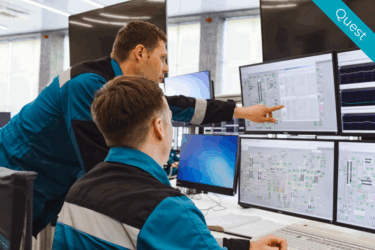The latest trends in the logistics industry – the new technology that matters

“Netflix is not even on the radar screen in terms of competition.” – Jim Keyes (Blockbuster CEO)
Reading the above statement with 20/20 hindsight might be amusing, but it is also a stark reminder of what can happen if we stop paying attention to new and emerging technology in our sector (and even beyond our own sector). Anecdotal evidence tells us that Jim Keyes wasn’t the only one to misjudge what was coming; Palm laughed that Apple couldn’t put a smartphone together, for example, and there are plenty of other examples out there too. The point is that businesses that adapt to new technology and adopt it as quickly as they can are the ones that are going to beat the competition. They are the ones that will keep pace with what is happening and will be aware of the latest trends in the logistics industry. They are the ones who will not be left behind to ultimately disappear altogether.
What are the latest trends in the logistics industry?
So just what is happening in logistics trends at the moment? What are the latest trends in the logistics industry? Much of the focus seems to be on physical automation and innovation. You can see that start-ups like Markforged, operating almost entirely in the hardware space, use 3D printing because it reduces the lead times from their supplier. And Tesla, Otto, and Mercedes to name just a few are all about driverless technology; there is going to be a fight to the finish to see who can develop it fastest. And because these are innovations that can be seen, felt, used in the physical sense, it is likely that this is why they are at the forefront of so many people’s minds. The truth, though, is that most small and medium sized business can’t afford to look to new developments in physical assets – the entry costs are often prohibitive, offering up nothing but a barrier to entry. What does this mean? Simply put, it means that rather than looking to engage with brand new technology, despite knowing what the latest trends in the logistics industry are, smaller businesses will instead turn inwards, looking at what they already use and finding new ways to use it.
Oil, Data & Next Month’s Numbers
Over the years, many tycoons have made their fortunes through oil, drilling down into land that they had bought cheap because no one had any use for it, not realising the ‘black gold’ that was lurking underneath. The oil hasn’t quite dried up, but something has certainly taken its place in the 21st century – data. Business leaders are looking at how to monetise data, just as Amazon, Google, Facebook, and Microsoft have all done. They are looking in their own backyards determining just how to use the data they already have to their advantage and in connection with the latest trends in the logistics industry. This is their oil. Data that no one else would have any use for could net them a fortune if they could just innovate their way though. SMEs are now latching onto the fact that their data no longer simply gives them 20/20 hindsight, but when combined with machine learning, provides very real actionable foresight.
The delivery of artificial intelligence and machine learning solutions for SMEs is now a reality, thanks to user friendly products suites such as Microsoft Dynamics 365. They provide finance and logistics solutions that are already integrated with their Azure Machine Learning platform, making things easier than ever, and enabling all small businesses to keep up to date with the latest trends in the logistics industry. What’s more, with so many SMEs making use of this technology, it is clear that bespoke solutions are no longer required if the technology is there for business owners to make their generalised tech more pursuant to what they want.
Another benefit of this kind of technology is that analysis of past performance is no longer a task that takes many hours to complete; it is automated, and gaining information about what is likely to occur within the next days and weeks can be found immediately, giving business owners time to change what needs to be changed (if anything). Although some might argue that this technology won’t take into account any particularly special nuances regarding the market or the time of year and so on, and that a human touch is the only way to get this information, it doesn’t seem as though it will be long before this additional information can be included.
When it comes to the latest trends in the logistics industry, is it small algorithms or artificial intelligence that makes more sense?
Artificial intelligence is definitely a buzzword that appears in almost every sector, for a variety of different reasons. It’s a catch-all, and a catchy one at that. However, true AI is different to most of what we call AI today. True AI is something that keeps learning and evolving, whereas the majority of what we think of as AI is actually just software that does something humans used to have to do (and does it well). This is a big distinction, especially since AI is getting more and more accurate as time goes on, and clever software, since it can’t grow its algorithms, is getting left further and further behind, and soon won’t feature in the latest trends in the logistics industry. During engagements with companies now, in addition to identifying how functionality can meet known requirements, we are having to ask ourselves what foresight and insight AI could add. For an outdoor activities and equipment business whose sales were highly weather-dependent, we established a machine learning model that correlated temperature and precipitation against sales, so that moving forward, they could use weather forecasts to predict stock requirements at different shop locations.
Using out of the box Microsoft Dynamics 365 functionality, our SME clients in the logistics sector are increasingly using the standard machine learning models provided for forecasting their inventory levels, sales and cash flow, and speeding up the flow of their business. The biggest emergent trends bringing direct effects are in mining their already available data for foresight that is enabling them to react ahead of time to threats and opportunities. Self-driving shipping and the robotised warehouse may still be a few years out for many, but knowing what’s coming up via data-driven foresight is the single most important innovation available to switch on now.
How can the latest trends in the logistics industry benefit your business?
For a more detailed overview of how today’s technology can benefit your business, please contact one of our experts today. Alternatively, please join us at our free upcoming event, where we will be discussing these issues and more besides.



